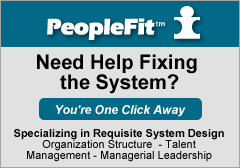Requisite Organization Design – Flat Ain’t All That, but Neither is Fat
By Michelle Malay Carter on April 29, 2009
 A client who is undergoing a Requisite Organization implementation received the following question from an employee, and I helped craft a response which you can read below.? They modified my suggested response before diseminating, and I added the pithy subheads before posting this.
A client who is undergoing a Requisite Organization implementation received the following question from an employee, and I helped craft a response which you can read below.? They modified my suggested response before diseminating, and I added the pithy subheads before posting this.
With more companies moving away from hierarchy-type organizations, how is a deeply more pronounced hierarchy at ClientCompany going to make it more effective?
Yes, People Are Hurt By Poorly Designed Organizations
It?s a sad reality that people get hurt and frustrated at work. The current trend is to blame hierarchies for this hurt because they seem to be the common denominator.
What Are the Real Issues?
In reality, it is uninformed organizational design, unclear accountability and authority, and lack of checks and balances within hierarchies that are the problem, not the hierarchies themselves.? The Requisite Leadership Framework that ClientCompany is adopting addresses each of these issues.
Hierarchy Does Not Equal Bad
Hierarchies, like bacteria, are not inherently bad.? Hierarchies are a natural form of human organization and have been observed within the earliest forms of civilization.? Remember, if there is even ONE leader within a group, a hierarchy exists.? What would the alternative be?
Egalitarianism??
Everyone is?accountable for working the teller line, making loans, cleaning the bathrooms, answering the phone, writing computer programs, and deciding where millions of dollars of deposits would be invested.
The problem is that everyone wants to take credit when all goes well, but there is only irresolvable finger pointing when things do not go well.? Who decides what to do then?? Who decides who does what job?? What is done when someone refuses to do a job assigned?? How is it decided who gets to assign work to whom?? How can someone be fired or hired?? Remember, there are no leaders.? The leader becomes the one with the biggest personality or the greatest ability to manipulate.
Use Knowledge to Design Effective Hierarchies
Back to our bacteria analogy, bacteria is not a problem per se, and eliminating all bacteria would destroy our ecosystem. ?Once we understand the properties of bacteria, we can use that knowledge to use bacteria to our advantage and reduce or eliminate the damage it can cause.? When there is too much, too little, or the wrong mix of bacteria, the efficiency and effectiveness of natural order of the system is affected.
It’s About Work Levels
Despite best intentions, ignorance surrounding work levels has left most people working in inefficient and ineffective organizational hierarchies that destroy productivity and morale.? It?s no wonder hierarchies get a bad rap.
The requisite organization framework helps us understand work by level and this allows us to create an organization design that results in natural order, efficiency, and effectiveness.? When organizational layering is correct without too many or too few layers, communication and assignments flow naturally up and down the hierarchy.
Neither Flat Nor Fat
It is only when there are too many or too few layers that communication and work either get bogged down or lost, resulting in frustration and inefficiency. R equisite understanding allows us to build a structure that will allow each employee to work at their full potential and to be led my someone who can offer appropriate leadership.
People welcome leaders who lead.? People resent being asked to work for someone who cannot lead them. The requisite model helps us provide employees with satisfying leadership.
Power Corrupts; Absolute Power Corrupts Absolutely
Can there be abuse of power within a hierarchy?? Of course, this is another danger.? The Requisite model pairs hierarchy with clear accountabilities, authorities, and checks and balances to reduce the likelihood of this common problem.
Adding accountabilities to the job description of all managers-once-removed is a unique characteristic of the requisite model designed to ensure that more than one set of eyes is on any given employee.? The manager-once-removed is accountable to ensure that his/her direct reports once removed (two layers down) are being treated fairly and are being considered for advancement and development.
Stick Out Your Arm Please
Before medical science understood bacteria, techniques like bloodletting were commonplace.? They were desperate attempts to do something to stop the pain.? Calling for the elimination of hierarchy or ?flat organizations?, etc. divorced from an understanding of work levels is simply the same thing, a hopeful attempt to reduce the pain caused by a poorly designed hierarchy.
Requisite Organization Payoff
We believe organizing requisitely will allow employees to work at their full potential, under the guidance of a satisfying leader, with the additional oversight and career mentoring of a manager once removed.? Additionally, we believe organizing requisitely will allow ClientCompany to continue to thrive in the future and provide a healthy workplace for its employees.
I’m OK.? You’re OK.? Let’s fix the system.
Filed Under Accountability, Executive Leadership, Managerial Leadership, Organization Design, Requisite Organization, Talent Management, Work Levels
